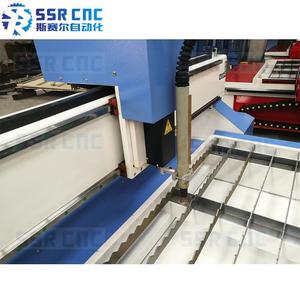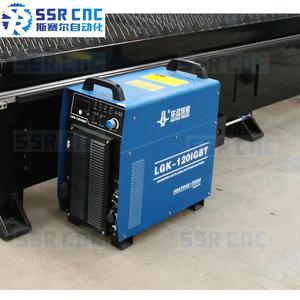
All categories
Featured selections
Trade Assurance
Buyer Central
Help Center
Get the app
Become a supplier

(1157 products available)





















Many types of cheap CNC plasma tables are available for sale, each designed to cater to different needs. Some are perfect for large-scale industrial projects, while others are flexible, portable, and budget-friendly for small-scale use.
Plasma Only Cutting Tables
A plasma only cutting table will only cut the metal and nothing else. This plasma-only table is more affordable than other alternatives that use multiple cutting methods.
Combined Cutting Table
A combined cutting table will use the plasma cutter and oxygen torch in tandem to cut various materials. Having two cutting methods on one table is more convenient than purchasing individual cutting tables.
Mini Plasma Cutting Tables
A mini plasma cutting table is suitable for small-scale use. The cheap CNC cutting tables can usually only cut up to 1 inch and may be limited to metal of a specific thickness. These mini tables are more affordable, but they also limit the size of cutting projects.
Portable Plasma Cutting Tables
Many people prefer the portable plasma cutting table to the more stationary options available. The downside is that it will usually cost more than a non-portable cutting table. A portable table provides the flexibility and convenience of taking the machine to the worksite rather than bringing the material to the machine.
Rotary Plasma Cutting Tables
A rotary table uses a motorized rotary gantry to move the metal part in a circular motion. The circular movement cuts the metal to produce round holes or curves. It is more common to find rotary CNC cutting machines being used in the oil, petrochemical, and shipbuilding industries.
Affordable Hobby Plasma Tables
Hobbyists who enjoy working with metal will want to look for a more affordable plasma table. These smaller-sized tables are more budget-friendly and usually have user-friendly features for those with less experience. Something to consider is whether the table is partially or fully assembled upon arrival.
Desktop CNC Plasma Tables
The cheap desktop plasma cutting table takes up much less space than a full-cutting table. The dimensions are more like a desktop computer. This small, affordable option will cut small parts but is great for home use.
Entry-Level CNC Plasma Tables
Many users want an entry-level CNC machine because of its easy-to-understand learning system and user-friendly operation. Beginners and those with limited experience will look for a machine that tracks and cuts with precision. The entry-level CNC tables usually come with an affordable price tag.
The table's specifications can vary depending on the type and model, but here are some general specifications representing their common features.
Optimum plasma tables, whether CNC or not, do the same thing: they use plasma gas to cut metal. The main difference is that with cheap CNC plasma tables, those cuts become computer-controlled. So, what are the uses of plasma tables in the industry?
Plasma tables, even manual ones, are helpful cutting tools in numerous industries. This list will consider the situations where plasma tables are staples, whether CNC-controlled or not.
Steel fabrication shops use plasma tables to create complicated steel shapes and profiles. The slabs begin as simple shapes but must become curved, notched, and punched for the final product. Furthermore, with CNC-control, every cut is accurate, which is impeccable for steel fabrication shops.
Automotive repair and restoration businesses use plasma tables to build custom parts. When repairing cars, especially classic ones, there is a need to build custom parts. Sometimes, a traditional cutting tool will not suffice. This is where plasma tables come in handy. They help create the custom parts with clean and precise cuts.
Architecture and construction plan to use plasma tables to cut decorative metal elements and architectural details. This will include light fixtures, gates, railings, and facades. All of these will have intricate designs that only a plasma table can cut.
Sign-making companies use plasma tables to create one-off or mass production of metal signage. Once again, it's the precision of the cuts and the beauty of the finished product that makes the metal signages desirable.
Art studios need plasma tables to make metal sculptures and other art pieces. For artists working with metal, a plasma table is a necessary tool. It allows them to express their creativity and make bold statements with their sculptures.
Aerospace manufacturers use plasma tables to cut lightweight metal alloys. Airlines want to keep their planes in the air. Using lightweight alloys and metals helps with this goal. When manufacturing parts with these materials, the only option is a CNC plasma table.
HVAC installers and manufacturers use plasma tables to cut ducting and other metal components. This is usually done on panels using CNC machines for the best results. The components will be uniform, and the cuts will all fit together seamlessly.
CNC plasma tables—and their manual counterparts—are useful cutting tools that help create and cut metal parts in all shapes, sizes, and designs. These are only some situations where plasma tables are integral.
These tips will guide buyers in selecting a cheap CNC plasma table that suits their business needs and budget.
Determine the cutting needs of the business
Consider the types of materials and thicknesses of metal that will be cut, as well as the desired cut quality and level of precision. If the business primarily works with thicker or more demanding materials, investing in a more powerful and advanced CNC plasma table may be beneficial to handle those specific requirements. For example, a heavy-duty CNC plasma table would work better for cutting thick steel used to manufacture industrial equipment, boats, or construction materials.
Evaluate the size and dimensions
Consider the dimensions and weight of the metal parts that will be produced. Ensure that the CNC plasma table has sufficient cutting area and weight capacity to accommodate those sizes. As a general guide, the cutting area of the plasma table should be at least 12 inches more than the length and width of the metal parts that will be cut. For example, if the largest metal part to be cut measures 60 inches by 40 inches, then the plasma should have a cutting area of at least 72 inches by 48 inches.
Consider a budget-friendly option without sacrificing quality
Look for reputable manufacturers or suppliers of plasma tables within budget. Consider features like software compatibility, automation, and ease of use. Minimize extra costs in the long run by selecting machines with low maintenance and operating costs.
Check for customer support and warranty
When choosing a budget plasma table, it's essential to consider the availability of customer support and warranty coverage. Ensure that the manufacturer or supplier offers reliable technical assistance and a reasonable warranty period. This will provide added peace of mind and protection for the investment.
Q1: How can buyers get cheap CNC plasma tables with good quality?
A1: Buyers can buy good quality cheap CNC tables by doing thorough research on manufacturers and suppliers. They should look for those with a track record of producing high-quality plasma tables. It is also important to read reviews and testimonials from previous customers to get insight into the kind of products a manufacturer offers. Buyers can also get good quality cheap CNC plasma tables by negotiating for better prices when dealing with suppliers and manufacturers in bulk.
Q2: What is the relationship between the cost of a CNC plasma table and its quality?
A2: Typically, the higher the table's quality, the higher the price. Cheap plasma tables are made of low-quality materials that may easily wear out or break. However, this is not to say that all cheap tables are of low quality. Some manufacturers produce affordable tables that are adequate for most users.
Q3: How much does a cheap CNC plasma table cost?
A3: Budget tables can go for as low as $5,000. However, this is subject to change depending on other factors such as market demand and supply, the pricing strategy of different manufacturers and suppliers, technological advancements, and inflation rates.